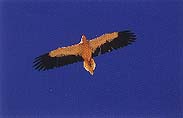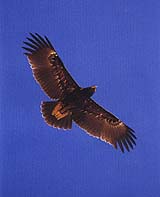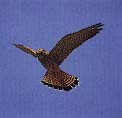BIRDS OF PREY IN SOUTHERN ARABIA
Text and pictures by Hanne and Jens Eriksen
The Oman Bird List* boasts no less than 36 species of birds of prey (vultures, hawks, eagles and falcons). The great majority of these are passage migrants and/or winter visitors: from November through April the sky over the Sultanate is filled with these birds, many of which are rare elsewhere. At least three species - Imperial Eagle, Spotted Eagle and Lesser Kestrel - are classified by BirdLife International as globally threatened, yet all three are regular visitors to Oman and easy to find. It is not uncommon to see a couple of species of vultures, perhaps five different species of eagles, a couple of harriers and a falcon or two on a single outing here.
 Vultures
Vultures
The most common species of this group is the Egyptian Vulture (Neophron percnopterus). A few pairs breed in the high mountains of Oman, but the numbers dramatically increase during the winter months when gatherings of up to 200 may be encountered. Its much bigger cousin, the Lappet-faced Vulture (Torgos tracheliotus) is a much sought after bird by resident and visiting birdwatchers. With a wing span of over three metres, it is the biggest bird in the sky and impressive by anyone's standard. When birds gather around a dead animal even the biggest eagles look like dwarfs again a Lappet-faced and will easily be driven away. In one instance, 35 Lappet-faced vultures were seen around a dead donkey.
 The Big Eagles
The Big Eagles
Three big Aquila eagles are regular if not common winter visitors: Steppe Eagle (A. nipalensis), Spotted Eagle (A. clanga) and Imperial Eagle (A. heliaca). All three seem to prefer the same habitat so one often encounters all three together. Steppe Eagles are the most common with flocks of 100 or more sometimes seen. Most of the birds are immatures from Eastern Europe and Central Asia. It is well known that immature birds of these species are far more migratory than adults which presumably only turn up here if the winter in their breeding range is particularly severe or food is in short supply. Rubbish dumps, sewage works and large farmlands are the best places to see these eagles and from November to March there will always be some present.
 Lesser Kestrel
Lesser Kestrel
One of the most attractive members of the falcon family, the Lesser Kestrel (Falco naumanni) is a fairly common spring passage migrant in Oman. They can be seen hovering over grasslands near Salalah and Sohar from about mid-March to mid-May. Their diet consists of grasshoppers and large beetles. The kestrels hover over the field and swoop down on their prey which is either eaten on the ground or taken to the air in the talons and eaten on the wing. Elsewhere, spraying fields with insecticides has undoubtedly affected these birds, but Oman seems to be a safe haven for them. 1994 was a particularly good year and in mid-April no less than 150 birds could be seen together on fields near Sohar.
With such variety and impressive numbers of birds of prey it is not surprising that visitors come from all over to birdwatch here. Recent visitors from Scandinavia reckoned that Oman was the best place in the world to study these birds.
*The 4th edition of the Oman Bird List was published by the Oman Bird Records Committee in January 1994. It lists all birds found in the Sultanate of Oman and gives the status of each species. It is available in Oman at the Natural History Museum and Family Bookshop. It is also available in the UK from the Ornithological Society of the Middle East. All bird sighting should be sent to: The Recorder, OBRC, PO Box 246, Muscat 113.
Web Links | Subjects | Search
Arabian Wildlife. Volume 2, Number 3